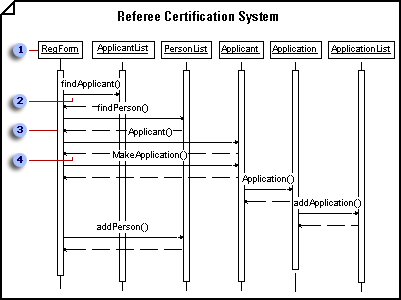About UML sequence diagrams
A type of interaction diagram, a sequence diagram shows the actors or objects participating in an interaction and the events they generate arranged in a time sequence. Often, a sequence diagram shows the events that result from a particular instance of a use case but a sequence diagram can also exist in a more generic form.
The vertical dimension in a sequence diagram represents time, with time proceeding down the page. The horizontal dimension represents different actors or objects.

The vertical dimension in a sequence diagram represents time, with time proceeding down the page. The horizontal dimension represents different actors or objects.
 Objects are represented as object lifelines, that is, in terms of their existence at a particular time. Adjust line length to indicate an object's creation or destruction.
Objects are represented as object lifelines, that is, in terms of their existence at a particular time. Adjust line length to indicate an object's creation or destruction.
 Arrows represent messages between objects. An object can also send a message to itself.
Arrows represent messages between objects. An object can also send a message to itself.
 Add an activation (also called a focus of control) to a lifeline to indicate the time period during which an object is performing an action.
Add an activation (also called a focus of control) to a lifeline to indicate the time period during which an object is performing an action.
 A return message is shown as a dashed line.
A return message is shown as a dashed line.
No comments:
Post a Comment